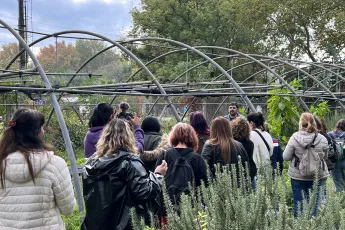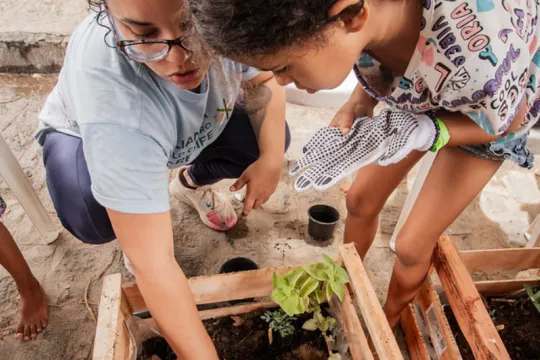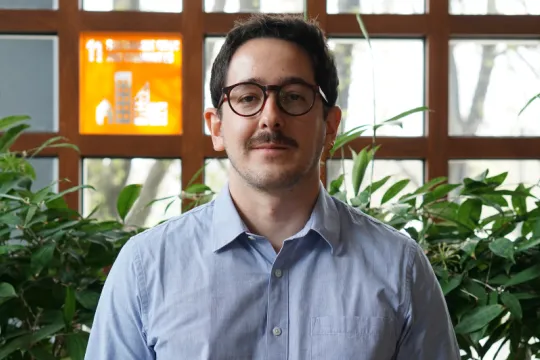
Tour of Rosario’s Agroecological Centre. © J. Hardoy / IIED LA
By: Anabella Ullo, Territorial technical coordinator of the housing axis of the Barrio 20 Reurbanization Project, Instituto de Vivienda de la Ciudad (IVC), Buenos Aires.
In May, different community and government actors involved in the Comprehensive Reurbanization Project (PIRU) of Barrio 20 in Buenos Aires had the opportunity to participate in an exchange visit to the city of Rosario. This visit was organized within the framework of the Transformative Urban Coalitions (TUC) project by the team of IIED – América Latina.
During the visit, we had the opportunity to learn about the participatory process that is being carried out in Barrio Moreno by the Public Housing Service, and we visited a vegetable garden where the Urban Agriculture Programme of the municipality of Rosario is implemented.
Barrio Moreno is a settlement close to downtown Rosario where a participatory reurbanization process has been carried out to promote socio-urban integration in that sector of the city. Much work has been done to permanently relocate the families previously inhabiting the areas currently occupied by the new infrastructure, which provides formal water supply and sewage services to all residences. Although all the points mentioned are similar to PIRU’s action fronts in Barrio 20, Buenos Aires, the visit to Barrio Moreno allowed us to exchange knowledge and challenges with Rosario's team.
PIRU in Barrio 20 is located in the south of the Autonomous City of Buenos Aires and it is where I do my work through IVC. The experience began in 2016, driven by the neighborhood’s residents. Today, PIRU exhibits notable progress: five streets and ten passages have been opened, and families have been relocated to Papa Francisco, the neighborhood that houses the new housing complex. We are currently planning and executing the construction of 19 passages, the definitive relocation of families, and housing, infrastructure and public space improvement works, in addition to land regularization, and sustainable environmental interventions and projects together with the TUC project and the local community.
It should be noted that from the beginning of the Barrio Moreno project, a public space has been proposed where the openings would include a wide sidewalk for people to walk comfortably, a space for seedbeds with trees and a street for vehicles. The trees were planted together with local residents, promoting their ownership and maintenance over time. I see this as an important aspect, as the environmental impact of such interventions has been considered from the start of the project; additionally, the collaborative way in which they have been carried out allows them to be sustainable. On the other hand, in Barrio 20, the construction of green spaces is a major challenge currently being addressed within the framework of the TUC project. The scale and density of Barrio 20 have influenced the number of families to be relocated, limiting the width of passages to 4 meters. As a result, adding high-quality green spaces within these narrow openings while also meeting the norms required by other regulatory agencies is quite a challenge that TUC is addressing together with IVC and local residents.
Both urban projects have made significant progress, and this is not solely due to government will but primarily because of the organization, participation and ownership demonstrated by local residents.
During the visit, we also learned about Rosario’s Urban Agriculture Programme, which over time has successfully evolved into a sustainable public, social, economic, food, cultural and urban-environmental policy for the city. A social policy because it arises from the community and seeks to promote integration and capacity development for the families that work in the vegetable gardens; an economic policy because it creates a production and commercialization activity for people involved; a food policy because it generates healthy agroecological products for consumers; a cultural policy because it sustains traditional knowledge related to food production from different generations and regions; an urban-environmental policy because it proposes new forms of land use and planning based on environmental protection and climate resilience.
The participatory reurbanization processes, the urban agriculture programme and the vegetable gardens of Rosario provide us great examples and encourage our commitment to rethink cities in an urban-environmental and participatory manner, bringing the two axes together to simultaneously tackle the climate and housing crises. The articulation between participatory urban processes demanded by the population and environmental sustainability projects shows us the transformative impact of sustainable urban planning. I carry these experiences with me to my work in order to rethink the way I perform my duties and articulate them in more transversal ways to respond to different problems with the least amount of resources possible and ensuring long-term sustainability.

